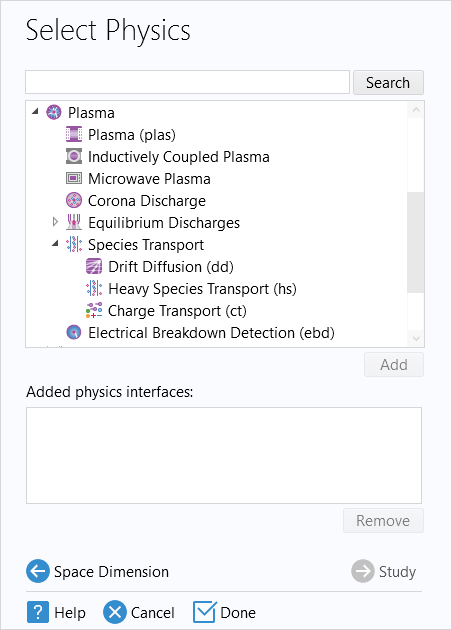Introduction to Nonequilibrium Plasma Modeling
Plasma modeling includes the description of phenomena such as the kinetics of charged and neutral species, mass transport, electromagnetic fields, heat transfer, and fluid mechanics. In this 6-part self-paced course, you will get an introduction to modeling plasma, with a focus on modeling nonequilibrium plasma, using the COMSOL Multiphysics®software and the Plasma Module. This includes learning about the fundamentals of modeling plasma, best modeling practices, the underlying equations used for the plasma physics interfaces and physics feature nodes, and the various specialized capabilities and features in the Plasma Module. We also discuss the possibilities and limitations of plasma modeling using the software. In addition, you will see various demonstrations of how to create simulations of different types of plasma applications.
Note: This course is meant for users that are familiar with COMSOL Multiphysics. If you are new to using the software we strongly recommend completing theintroductory tutorial seriesfor new users or attending a live, introductorytraining coursebefore starting this Learning Center course. Additionally, some familiarity with the basic concepts of plasma physics is advantageous.

TheSelect Physicswindow with thePlasmabranch of physics interfaces expanded. The options displayed are those available for modeling in 3D.
An overview of the topics covered throughout the course are as follows:
Part 1:Introduction to Nonequilibrium Discharges and Plasma Modeling
- Introduction to nonequilibrium discharges
- Plasma Module validity and capabilities
- Introduction to thePlasmainterface
- Drift Diffusioninterface
- Heavy Species Transportinterface
- Plasma chemistry
- Electrostaticsinterface
Part 2:Using the Plasma Interface
- Overview of thePlasmainterface settings
- Diffusion Modeloptions
- Transport Settingsoptions
- Plasma Propertiessettings
- Demo: Simulating DC glow discharge
- Further information on thePlasmainterface
- Finite volume formulation
- Debugging plasma models
- Stabilization
Part 3:Debugging Plasma Models and Using the Plasma, Time Periodic Interface
- Debugging plasma models
- Demo: Resolving common error and warning messages
- Introduction to thePlasma, Time Periodicinterface and relevant study types
- Demo: Computing plasma impedance
- Further information on thePlasma, Time Periodicinterface
- General tips on when to use thePlasmainterface versus thePlasma, Time Periodicinterface
- Handling complex plasma chemistries
Part 4:Modeling Inductively Coupled Plasma and Microwave Plasma
- Introduction to theInductively Coupled Plasmainterface
- Demo: Modeling a GEC ICP reactor
- Introduction to theMicrowave Plasmainterface
- Demo: Simulating microwave plasma
- Further information on theMicrowave Plasmainterface
- Resonance zone smoothing using theDoppler broadening parameteroption
- Portboundary condition properties
- Additional resources for further learning
Part 5:Understanding the Electron Energy Distribution Function and Boltzmann Equation, Two-Term Approximation
- Introduction to the electron energy distribution function (EEDF)
- Review the different options and possibilities for describing the distribution function
- Comparing the different options
- Introduction to theBoltzmann Equation, Two-Term Approximationinterface
- How to use the interface
- Further settings required upon use of the interface
- Relevant study types
- Demo: Performing an argon Boltzmann analysis
- Space-dependent EEDF modeling and why using anEEDF Initializationstudy for this is necessary
Part 6:Modeling Plasma with CFD and Heat Transfer
- Coupling plasma with fluid flow and heat transfer
- Relevant settings in thePlasmainterface
- Thermodynamic properties
- Species properties
- Accounting for convection
- Demo: Setting up a thermal plasma model
- Electric discharges
- Introduction to theCorona Dischargeinterface
- Introduction to theElectrical Breakdown Detectioninterface
- Ion energy distribution function (IEDF) and particle tracing
A plot of the electron density for a model of a GEC ICP reactor, built in Part 4 of this course.
After completing this course, you will be knowledgeable in the relevant theory for plasma modeling and have a complete understanding of what thePlasmainterface, as well as other interfaces, in COMSOL Multiphysics can be used for. You will also be aware of the various specialized features for plasma modeling, study types for analyses of plasma systems, and the additional resources available for learning more beyond the scope of this course.
Please note that the videos featured in this course were taken from a previous recording; because of this, some slides feature a daily agenda that is not relevant to this course.
请提交与此页面相关的反馈,或点击此处联系技术支持。
